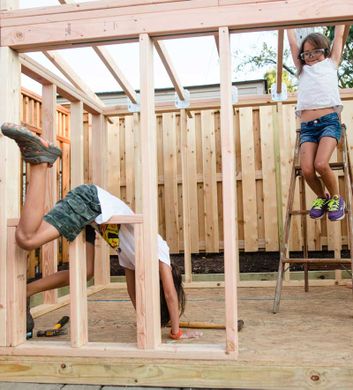Construction loan interest rates in January 2026
For owner occupiers, construction loan interest rates currently start at:
- Fixed: 4.95% p.a. (comparison rate^ 5.40% p.a.) fixed for 3 years on Teachers Mutual Bank (Group) Your Way Plus Fixed.
- Variable: 5.14% p.a. (comparison rate^ 5.15% p.a.) on People's Choice Credit Union Basic Variable Home Loan.
For investors, construction loan rates currently start at:
- Fixed: 5.14% p.a. (comparison rate^ 5.39% p.a.) on Move Bank Everyday 2-Year Fixed Home Loan.
- Variable: 5.29% p.a. (comparison rate^ 5.30% p.a.) on People's Choice Credit Union Basic Variable Investment Home Loan.
Best construction loan rates for owner-occupiers
Top 10 variable construction loan rates
| Loan | Interest rate | Comparison rate^ | Max LVR |
|---|---|---|---|
| RACQ Bank Fair Dinkum Home Loan | 5.14% | 5.15% | 60% |
| RACQ Bank Fair Dinkum Home Loan | 5.14% | 5.15% | 60% |
| The Mac Credit Union Discounted Basic Variable Home Loan | 5.17% | 6.83% | 80% |
| Hume Bank liteBlue Variable | 5.24% | 5.25% | 60% |
| People First Bank Basic Variable Home Loan | 5.24% | 5.25% | 70% |
| People's Choice Credit Union Basic Variable Home Loan | 5.24% | 5.25% | 70% |
| Heritage Bank Discount Variable OO P&I | 5.24% | 5.26% | 70% |
| BCU Bank OMG Home Loan | 5.24% | 5.27% | 60% |
| Regional Australia Bank Variable Home Loan | 5.24% | 5.27% | 60% |
| Regional Australia Bank Variable Home Loan | 5.24% | 5.27% | 70% |
Top 10 fixed (1-year) construction loan rates
| Loan | Interest rate | Comparison rate^ | Max LVR |
|---|---|---|---|
| Move Bank Everyday Fixed Home Loan | 5.14% | 5.28% | 95% |
| Hume Bank myBlue Fixed | 5.19% | 5.33% | 60% |
| Credit Union SA Fixed Home Loan Package | 5.19% | 5.88% | 97% |
| Beyond Bank Total Home Loan Package Fixed OO PI | 5.24% | 6.18% | 80% |
| Heritage Bank Standard Variable OO P&I Fixed | 5.29% | 7.84% | 95% |
| Move Bank Offset Fixed Home Loan | 5.34% | 5.48% | 95% |
| Regional Australia Bank Fixed Home Loan | 5.40% | 5.28% | 60% |
| Regional Australia Bank Fixed Home Loan | 5.40% | 5.28% | 70% |
| Westpac Premier Advantage Rocket Repay Home Loan Fixed | 5.49% | 6.00% | 70% |
| Bank of Melbourne Fixed Rate Home Loan Advantage Package | 5.49% | 6.01% | 70% |
Top 10 fixed (2-year) construction loan rates
| Loan | Interest rate | Comparison rate^ | Max LVR |
|---|---|---|---|
| Regional Australia Bank Fixed Home Loan | 4.98% | 5.22% | 70% |
| Regional Australia Bank Fixed Home Loan | 4.98% | 5.22% | 60% |
| Move Bank Everyday Fixed Home Loan | 4.99% | 5.24% | 95% |
| The Mutual Bank Standard Fixed Home Loan | 5.04% | 7.32% | 95% |
| Regional Australia Bank Fixed Home Loan | 5.08% | 5.32% | 80% |
| Hume Bank myBlue Fixed | 5.19% | 5.31% | 60% |
| Move Bank Offset Fixed Home Loan | 5.19% | 5.44% | 95% |
| Beyond Bank Total Home Loan Package Fixed OO PI | 5.19% | 6.11% | 80% |
| Orange Credit Union Premium Fixed Home Loan | 5.25% | 5.56% | 95% |
| Credit Union SA Fixed Home Loan Package | 5.29% | 5.87% | 97% |
Top 10 fixed (3-year) construction loan rates
| Loan | Interest rate | Comparison rate^ | Max LVR |
|---|---|---|---|
| Move Bank Everyday Fixed Home Loan | 5.04% | 5.23% | 95% |
| The Mutual Bank Standard Fixed Home Loan | 5.04% | 7.08% | 95% |
| Beyond Bank Total Home Loan Package Fixed OO PI | 5.19% | 6.05% | 80% |
| Move Bank Offset Fixed Home Loan | 5.24% | 5.43% | 95% |
| Hume Bank myBlue Fixed | 5.29% | 5.33% | 60% |
| Regional Australia Bank Fixed Home Loan | 5.30% | 5.28% | 70% |
| Regional Australia Bank Fixed Home Loan | 5.30% | 5.28% | 60% |
| Regional Australia Bank Fixed Home Loan | 5.39% | 5.38% | 80% |
| Credit Union SA Fixed Home Loan Package | 5.39% | 5.88% | 97% |
| Heritage Bank Standard Variable OO P&I Fixed | 5.39% | 7.37% | 95% |
Top 10 fixed (4-year) construction loan rates
| Loan | Interest rate | Comparison rate^ | Max LVR |
|---|---|---|---|
| Hume Bank myBlue Fixed | 5.29% | 5.32% | 60% |
| Regional Australia Bank Fixed Home Loan | 5.52% | 5.37% | 70% |
| Regional Australia Bank Fixed Home Loan | 5.52% | 5.37% | 60% |
| Beyond Bank Total Home Loan Package Fixed OO PI | 5.59% | 6.14% | 80% |
| Regional Australia Bank Fixed Home Loan | 5.61% | 5.46% | 80% |
| Regional Australia Bank Fixed Home Loan | 5.79% | 5.81% | 90% |
| Westpac Premier Advantage Rocket Repay Home Loan Fixed | 5.89% | 6.10% | 70% |
| Bank of Melbourne Fixed Rate Home Loan Advantage Package | 5.89% | 6.11% | 70% |
| Bank SA Fixed Rate Home Loan Advantage Package | 5.89% | 6.11% | 70% |
| St George Bank Fixed Rate Home Loan Advantage Package | 5.89% | 6.11% | 70% |
Top 10 fixed (5-year) construction loan rates
| Loan | Interest rate | Comparison rate^ | Max LVR |
|---|---|---|---|
| Move Bank Everyday Fixed Home Loan | 5.29% | 5.31% | 95% |
| Hume Bank myBlue Fixed | 5.39% | 5.36% | 60% |
| Move Bank Offset Fixed Home Loan | 5.49% | 5.51% | 95% |
| Beyond Bank Total Home Loan Package Fixed OO PI | 5.59% | 6.12% | 80% |
| Suncorp Bank Standard First Home Buyer OO PI Fixed | 5.59% | 6.17% | 95% |
| Heritage Bank Standard Variable OO P&I Fixed | 5.59% | 7.06% | 95% |
| Regional Australia Bank Fixed Home Loan | 5.74% | 5.48% | 60% |
| Regional Australia Bank Fixed Home Loan | 5.74% | 5.48% | 70% |
| Regional Australia Bank Fixed Home Loan | 5.83% | 5.58% | 80% |
| Westpac Premier Advantage Rocket Repay Home Loan Fixed | 5.89% | 6.12% | 70% |
Best construction loan rates for investors
Top 10 variable construction loan rates
| Loan | Interest rate | Comparison rate^ | Max LVR |
|---|---|---|---|
| RACQ Bank Fair Dinkum Home Loan | 5.34% | 5.35% | 60% |
| Hume Bank liteBlue Variable | 5.39% | 5.40% | 60% |
| People First Bank Basic Variable Investment Loan | 5.39% | 5.40% | 70% |
| People's Choice Credit Union Basic Variable Home Loan | 5.39% | 5.40% | 70% |
| Heritage Bank Discount Variable Inv P&I | 5.39% | 5.41% | 70% |
| Move Bank Everyday Variable Home Loan | 5.39% | 5.44% | 80% |
| Credit Union SA Variable Home Loan Package Special Offer | 5.39% | 5.77% | 60% |
| Regional Australia Bank Variable Investor Home Loan | 5.44% | 5.47% | 60% |
| Regional Australia Bank Variable Investor Home Loan | 5.44% | 5.47% | 70% |
| Newcastle Permanent Building Society Real Deal Basic Variable Inv <80% LVR P&I Special | 5.44% | 5.48% | 80% |
Top 10 fixed (1-year) construction loan rates
| Loan | Interest rate | Comparison rate^ | Max LVR |
|---|---|---|---|
| Move Bank Everyday Fixed Home Loan | 5.29% | 5.43% | 90% |
| Community First Bank Boost Package home loan fixed investment | 5.29% | 5.90% | 80% |
| Illawarra Credit Union Boost Package Home Loan Fixed Investment | 5.29% | 5.90% | 80% |
| Hume Bank myBlue Fixed | 5.39% | 5.48% | 60% |
| Credit Union SA Fixed Home Loan Package | 5.39% | 6.12% | 97% |
| Beyond Bank Standard Investment Loan Fixed | 5.44% | 6.29% | 80% |
| Move Bank Offset Fixed Home Loan | 5.49% | 5.63% | 90% |
| Heritage Bank Standard Variable Inv P&I Fixed | 5.49% | 8.34% | 90% |
| Bank Australia Basic Fixed Investment Loan | 5.54% | 5.59% | 60% |
| Bank Australia Premium Fixed Investment Loan Package | 5.54% | 5.69% | 60% |
Top 10 fixed (2-year) construction loan rates
| Loan | Interest rate | Comparison rate^ | Max LVR |
|---|---|---|---|
| Move Bank Everyday Fixed Home Loan | 5.14% | 5.39% | 90% |
| Community First Bank Boost Package home loan fixed investment | 5.14% | 5.85% | 80% |
| Illawarra Credit Union Boost Package Home Loan Fixed Investment | 5.14% | 5.85% | 80% |
| The Mutual Bank Standard Fixed Home Loan | 5.14% | 7.65% | 95% |
| Regional Australia Bank Fixed Investor Home Loan | 5.19% | 5.42% | 70% |
| Regional Australia Bank Fixed Investor Home Loan | 5.19% | 5.42% | 60% |
| Credit Union SA Fixed Home Loan Package | 5.24% | 6.06% | 97% |
| Regional Australia Bank Fixed Investor Home Loan | 5.29% | 5.52% | 80% |
| Move Bank Offset Fixed Home Loan | 5.34% | 5.59% | 90% |
| Community First Bank Boost Package home loan fixed investment | 5.34% | 6.12% | 95% |
Top 10 fixed (3-year) construction loan rates
| Loan | Interest rate | Comparison rate^ | Max LVR |
|---|---|---|---|
| The Mutual Bank Standard Fixed Home Loan | 5.14% | 7.38% | 95% |
| Move Bank Everyday Fixed Home Loan | 5.19% | 5.38% | 90% |
| Community First Bank Boost Package home loan fixed investment | 5.19% | 5.83% | 80% |
| Illawarra Credit Union Boost Package Home Loan Fixed Investment | 5.19% | 5.83% | 80% |
| Credit Union SA Fixed Home Loan Package | 5.29% | 6.03% | 97% |
| Move Bank Offset Fixed Home Loan | 5.39% | 5.58% | 90% |
| IMB Bank Fixed Rate Home Loan Investment - Up to $4k Cashback | 5.39% | 5.75% | 90% |
| Community First Bank Boost Package home loan fixed investment | 5.39% | 6.09% | 95% |
| Illawarra Credit Union Boost Package Home Loan Fixed Investment | 5.39% | 6.09% | 95% |
| Beyond Bank Standard Investment Loan Fixed | 5.39% | 6.18% | 80% |
Top 10 fixed (4-year) construction loan rates
| Loan | Interest rate | Comparison rate^ | Max LVR |
|---|---|---|---|
| Regional Australia Bank Fixed Investor Home Loan | 5.73% | 5.57% | 60% |
| Hume Bank myBlue Fixed | 5.74% | 5.58% | 60% |
| Regional Australia Bank Fixed Investor Home Loan | 5.87% | 5.62% | 70% |
| Beyond Bank Standard Investment Loan Fixed | 5.89% | 6.31% | 80% |
| Regional Australia Bank Fixed Investor Home Loan | 5.95% | 5.71% | 80% |
| Westpac Premier Advantage Rocket Repay Investment Fixed | 6.09% | 6.30% | 70% |
| Bank of Melbourne Fixed Rate Home Loan Advantage Package | 6.09% | 6.31% | 70% |
| Bank SA Fixed Rate Home Loan Advantage Package | 6.09% | 6.31% | 70% |
| Regional Australia Bank Fixed Investor Home Loan | 6.14% | 6.13% | 90% |
| Beyond Bank Total Home Loan Package Building Loan - Fixed | 6.19% | 6.48% | 90% |
Top 10 fixed (5-year) construction loan rates
| Loan | Interest rate | Comparison rate^ | Max LVR |
|---|---|---|---|
| Move Bank Everyday Fixed Home Loan | 5.44% | 5.46% | 90% |
| Move Bank Offset Fixed Home Loan | 5.64% | 5.65% | 90% |
| IMB Bank Fixed Rate Home Loan Investment - Up to $4k Cashback | 5.69% | 5.83% | 90% |
| Hume Bank myBlue Fixed | 5.74% | 5.60% | 60% |
| Heritage Bank Standard Variable Inv P&I Fixed | 5.79% | 7.44% | 90% |
| Bank Australia Basic Fixed Investment Loan | 5.89% | 5.72% | 60% |
| Bank Australia Premium Fixed Investment Loan Package | 5.89% | 5.86% | 60% |
| Beyond Bank Standard Investment Loan Fixed | 5.89% | 6.30% | 80% |
| Regional Australia Bank Fixed Investor Home Loan | 5.95% | 5.69% | 60% |
| Regional Australia Bank Fixed Investor Home Loan | 6.09% | 5.75% | 70% |
How do construction loans work?
A construction loan, also known as a ‘building loan’, is designed for borrowers constructing a new home or investment property. It can also be used for a house and land package, as well as major renovations or structural improvements to an existing property.
Unlike a standard home loan where you receive the full funds upfront, a construction loan is paid out in stages as the building progresses. This is known as a ‘progressive drawdown’. Here’s how it works:
Slab
This is when the foundation slab is measured and poured, with some of the plumbing installed. It usually accounts for 15-20% of the total loan and may also include your initial deposit to the builder, which is generally 5% of your building contract price.
Frame
This stage covers building the external frame, including the roof, walls, windows, and trusses. Electrical and plumbing conduits are also installed. It usually makes up about 20% of the total loan.
Lock-up
Construction of internal walls, doors and insulation of the home. This includes everything to ‘lock up’ your property and make it weathertight. This phase generally accounts for 20% of the total loan.
Fit-out
The finer details of the home are added, including shelving, kitchen and bathroom cabinetry, tiles and internal cladding. This represents about 30% of the funds.
Completion
The final touches that complete the home. This may include installation of retaining walls or fences as well as cleaning of the site. It generally accounts for roughly 10% of the total loan.
Construction loans come with a specific timeframe. Most lenders allow six months to draw on the loan and up to 24 months to complete the construction of the property.
When might you need a construction loan?
You may need a construction loan if you plan to:
- Build on land you’ve purchased: If you’ve already bought land with the intention of building a home or investment property, a construction loan will cover the building costs as the project goes ahead.
- Buy a house and land package: This involves purchasing both a block of land and a home to be built on it. You would need a land loan to cover the cost of the block, while a construction loan would finance the building costs of the home.
- Demolish a property or undertake major renovations: If you’re purchasing a property with plans to demolish it and build something new, or undertake large renovations or structural improvements, a construction loan can cover these costs.
Benefits of a construction loan
Here are some of the key advantages of taking out a construction loan:
Interest-only options
During the build, you can opt for interest-only repayments, helping to keep your cash flow manageable during the construction loan term (usually up to 24 months). This can be extremely beneficial if you’re renting or already paying a mortgage as you build or renovate.
Funds are released in stages
Instead of receiving the full loan amount upfront, funds are paid out in stages as construction progresses. This staged approach (typically five to six payments) means you only pay interest on the funds you’ve drawn, keeping your interest costs lower.
Option to link an offset account
Some lenders let you connect an offset account to your construction loan. This feature helps reduce the interest you pay by offsetting your loan balance with the money you hold in the account – a handy benefit commonly offered with variable rate home loans.
Added flexibility
Many lenders allow extra repayments, helping you pay down your loan faster and cut down on interest. If you already own a property, you might also be able to use your existing equity as security for the new construction loan.
A quick note about construction loan interest rates…
Construction loans typically have higher interest rates than standard home loans because they’re secured by an asset that doesn’t exist yet, therefore presenting more risk for lenders. And you’ll only pay interest on the amount you’ve drawn down as each stage of your construction is due.
How to get a construction loan
We asked Debbie Hays, Senior Mortgage Broker at Money.com.au, to walk us through how the process typically works when you go through a mortgage broker:
Talk to a mortgage broker
Before anything else, speak with an experienced mortgage broker. A broker will assess your goals, budget and financial position to determine how much you can borrow and what type of construction loan best suits your project.
They’ll explain how a construction loan works, including progress payments. They’ll also prepare your home loan application and help with anything else that’s required once your build is nearing completion and ready for you to move into. Importantly, brokers are paid by the lender, so their service is completely free to you.
Choose your builder and get a quote
Once you have an idea of your borrowing capacity, choose a licensed builder and obtain a fixed-price building contract, including plans and specifications for your build. This should outline the total cost of construction, broken down by stages.
You’ll also need to provide copies of building permits, council approved plans and the builder’s insurance details – all of which the lender will require prior to commencement for your build.
Review loan options
Your broker will compare construction loan products from multiple lenders, taking into account rates, features and flexibility. They’ll present you with tailored options and explain the pros and cons of each, so you can make an informed choice.
Submit your application
Once you’ve selected your preferred lender, your broker will prepare and lodge your application. They’ll collect your supporting documents (such as income verification, savings history and building contract details) and handle communication with the lender throughout the process.
Get approved and start building
Once your application is approved, the lender will issue a formal loan offer outlining the terms and process once progressed to their construction team. After you accept, the funds will be released in stages (called “progress payments" in line with your fixed price build contract) as construction moves through each milestone.
During construction, your builder will send invoices according to the progress payment schedule. Your broker will stay in touch to make sure payments are processed on time and everything runs smoothly right through to completion – when your new home is ready for handover and move-in.
How progress payments and valuations work during construction

Debbie Hays, Senior Mortgage Broker
“While your builder will outline stage-by-stage progress payments in your fixed-price building contract, the bank will make those payments directly to the builder. During construction, the bank will arrange for a valuer to inspect the property to confirm the work is progressing according to the contract. As completion approaches and your builder provides a handover date, the bank will order a final valuation to ensure the finished build (including any approved variations) aligns with the fixed price build contract and approved loan amount.”
Debbie Hays, Senior Mortgage Broker
What documents you’ll need when applying
To apply for a construction loan, you’ll need to give the lender the following documents:
- Proof of ID (e.g. driver’s licence, passport or birth certificate)
- 3-6 months of bank statements showing your living expenses and proof of savings
- Proof of income (e.g. payslips for PAYG employees, BAS statements for business owners)
- Details of your other debts and assets (e.g. credit cards, car loans or properties)
Other documents you may need
A contract of sale for the land you’re building on
You’ll need to show a signed contract of sale for the land you plan to build on or some other proof of ownership (e.g. a property title with your name on it) before a lender can approve you for a building loan.
A fixed-price building contract
While some builders are reluctant to offer fixed-price building contracts (due to quickly-rising costs), it’s usually a requirement of the lender that the contract is based on a fixed price.
This will generally need to include:
- An outline of each construction stage
- A progress payment schedule
- A construction timeline
- Total costs for the project
The lender may also ask for a copy of the builder’s licence.
Council approved building plans and permits
Your builder or architect will also provide this and will include all details of your home including layout, size, specifications, materials used and more. You can also search for extracts of building approval records for your property on your local council’s website.
Proof of insurance
The lender will want proof that the property and project are adequately insured throughout. This generally includes:
- Builder’s all risk insurance: Also known as home builder’s insurance, it covers risk to the building during construction.
- Domestic/home warranty insurance: You’ll need this if you’re using a registered builder. It covers risks like non-completion due to the builder's death, insolvency, or disappearance, as well as structural defects from builder negligence.
- Public liability insurance: Covers damage to property or injury to people relating to the construction.
The lender will conduct an ‘as if complete’ valuation

Debbie Hays, Senior Mortgage Broker
“Before your construction loan is formally approved, your lender will arrange a valuation of the property on an ‘as if complete’ basis. The valuer will need the signed building contract, plans, and specifications to do this. They’ll assess the estimated value based on recent sales of comparable homes in the area, ensure your build costs are in line with industry standards and confirm your end position – which helps the lender determine whether mortgage insurance is required.”
Debbie Hays, Senior Mortgage Broker
Can you build or renovate without a construction loan?
You generally need a construction loan to build a new home or carry out major structural renovations to a home. Lenders are usually reluctant to provide finance for a major building project upfront through a standard home loan.
However, for non-structural work, a construction mortgage may not be necessary. Instead, if you have a high level of equity in your property, you may be able to refinance your home loan to borrow more (known as a top-up).
Our home loans expert, Debbie Hays, offers the following example:
- “Let's think about a property owner with a home worth $1 million and $500,000 of equity. In other words, their home loan is $500,000."
- “And let’s say they want to do a couple of non-structural renos costing $200,000 in total. What they can do is talk to their bank or mortgage broker and say, ‘I want to release equity’."
- “If the bank approves it, it will increase their existing loan from $500,000 to $700,000, with a new separate loan account the borrower can withdraw from to pay for the renovations as they need it."
- “Now instead of the 50% equity they started with, it's back at 30%.”











